微观经济学 期末考试
微观经济学期末题及答案

考试复习一、名词解释1、机会成本:人们为了得到某种东西,而所要放弃另一些东西的最大价值.2、生产者剩余:卖者出售一种物品得到的量减卖者的成本。
3、边际产量递减规律:在一定时间内,随着对某种物品或劳务消费量的增加,从该物品或劳务得到的边际效用(新增的或边际的效用量)递减。
4、外部效应:在实际经济活动中,生产者或者消费者的活动对其他生产者或消费者带来的非市场性影响。
5、公共物品:既无排他性,又无竞争性的物品。
6、需求价格弹性:一种物品需求量对其价格变动反应程度的衡量,用需求量变动百分比除以价格变动百分比来计算.7、恩格尔定律:在其他条件不变的情况下,随着收入水平的提高,食品支出占消费总支出的比重有下降趋势。
8、消费者剩余:消费的支付意愿与实际支付的价格之差。
9、边际报酬递减规律:在其他条件不变的情况下,如果一种投入要素连续地等量增加,增加到一定产值后,所提供的产品的增量就会下降,即可变要素的边际产量会递减。
10、市场失灵:市场机制(价格调节市场的机制)不能实现资源的有效配置,即市场机制造成资源的配置失当.二、单选1、经济学研究的基本问题是( D ).A、人们的消费行为B、证明市场可以配置资源C、选择最公平的收入分配方式D、稀缺资源的配置与利用问题2、一国生产可能边界以内的一点表示( B ).A、通货膨胀B、失业或者资源没有被充分利用C、该国技术水平提高D、产品供求平衡3、在得出某种商品的个人需求曲线时,下列因素除哪一项外均保持不变( D )A、个人收入B、其余商品价格C、个人偏好D、所考虑商品的价格4、下列对吉芬商品描述正确的是( B )A、收入上升时,需求量也上升;价格上升时,需求量上升。
B、收入上升时,需求量也下降;价格上升时,需求量上升。
C、收入上升时,需求量也下降;价格上升时,需求量下降。
D、收入上升时,需求量也上升;价格上升时,需求量下降。
5、如果价格下降10%能使消费者总支出增加1%,则这种商品的需求量对价格( A )A、富有弹性B、具有单元弹性C、缺乏弹性D、其弹性不能确定6、某个消费者的无差异曲线图包含无数条无差异曲线,因为( B )A、收入有时高,有时低B、欲望是无限的C、消费者人数是无限的D、商品的数量是无限的7、商品X与商品Y的价格以及消费者的收入都按同一比率同方向变化,预算线将( C )A、向左下方平行移动B、向右上方平行移动C、不变动D、向左下方或右上方平行移动8、若同学甲的边际替代率MRS XY小于同学乙的边际替代率MRS XY,对同学甲来说可以( A )来增加效用。
微观经济学期末考试测试题及答案

一、单选题1、关于生产可能性边界的性质,下面哪个说法是错的()A.凸向原点B.一个商品转换成另外一个商品的比率越来越小C.负斜率D.技术进步时可以向外推移正确答案:A2、一个商品价格的上升会趋向于产生如下结果()A.另外一个商品需求增加B.互补商品需求量减少C.互补商品需求减少D.另外一个商品需求减少正确答案:C解析:C、注意需求的变化与需求量的变化3、如果冬天天气变得异常的寒冷,那么我们可以预测电力价格变化如下(最好要在脑海中有供求曲线):A.发电厂会为了进一步提高价格,有可能会进一步减少发电量B.寒冷导致电力供给减少,因此电力价格上涨C.发电厂的发电量会增加,因此电力价格不变D.寒冷导致电力需求增加,因此电力价格上涨正确答案:D4、关于供求均衡价格论,如下哪种说法是正确的()(由于选项在出现时是随机排序的,请大家注意理解)A.虽然a是对的,但是存在着一些例外,有些因素是在供求之外影响到价格的B.a是对的,但是是针对均衡价格而言的,如果是非均衡价格,就和供给与需求无关了C.a.无论是什么因素对均衡价格的影响,都可以归结为供给方面,或需求方面,或供给与需求两方面D.均衡价格一旦形成,就绝不会再改变,无论外在条件发生了什么变化正确答案:C5、在一个加油站,汽油价格每天都在变化之中。
一个司机过来后,没有看价格就直接说,给我加40升的汽油()A.司机的需求价格弹性为单位弹性B.司机对汽油的需求是完全弹性的C.司机的需求价格弹性为零D.司机对汽油的需求价格弹性为无限大正确答案:C6、已知需求方程为D=M/P(M为任意常数),那么()A.这种需求的需求价格弹性为单位弹性B.因为需求价格弹性与斜率成反比,所以需求曲线上左边的点的需求价格弹性较小C.因为需求曲线上左边所对应的价格较高,所以需求曲线上左边的点所对应的需求价格弹性较大D.这种需求函数属于线性需求函数正确答案:A7、已知需求方程为D=A/P,关于其需求价格弹性,如下事实成立:A.需求价格弹性绝对值随着价格上升先上升后下降B.需求价格弹性绝对值随着价格上升而上升C.需求价格弹性绝对值总是等于1D.需求价格弹性绝对值随着价格上升而下降正确答案:C8、关于需求的交叉价格弹性:A.弹性为负意味着两商品的互补关系B.对任意两个商品而言,弹性不可能为零C.弹性为负意味着两商品的替代关系D.弹性为正意味着两商品的互补关系正确答案:A9、已知供给方程为S=20P,其供给弹性为:A.-1B.1C.20D.依价格而定正确答案:B10、关于序数效用理论,如下哪些说法是正确的?A.如果(X,Y)的效用是(4,1),那有可能是因为X的价格比Y的价格要低B.其余说法全错C.如果(X,Y)的效用是(4,1),那就意味着,X和Y的效用都非常小D.如果(X,Y)的效用是(4,1),我们就说X的效用是Y的效用的4倍正确答案:B11、边际替代率如果用MRS表示的话,我们有两个公式成立:公式1:MRS=MUX/MUY,公式2:MRS=∆Y/∆X。
微观经济学期末考试试卷及参考答案
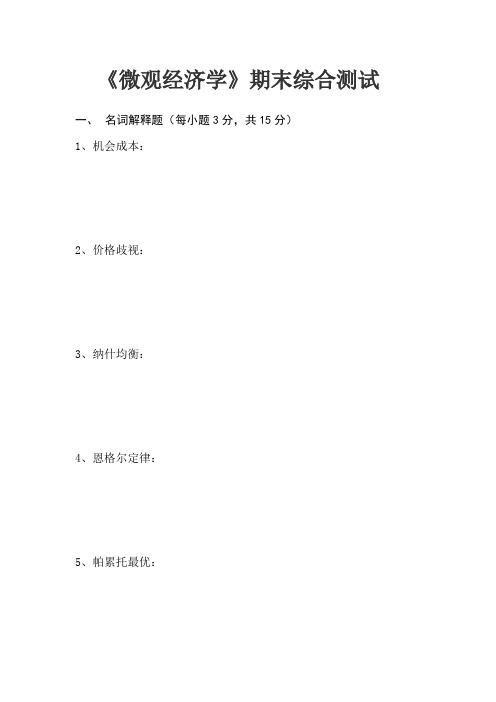
《微观经济学》期末综合测试一、名词解释题(每小题3分,共15分)1、机会成本:2、价格歧视:3、纳什均衡:4、恩格尔定律:5、帕累托最优:二、单项选择题(每小题1分,共15分)1、下列的说法中正确的是()。
A.生产要素的边际技术替代率是规模报酬递减规律造成的B.边际收益递减规律是规模报酬递减规律造成的C.规模报酬递减是边际收益递减规律造成的D.生产要素的边际技术替代率递减是边际收益递减规律造成的2、按照古诺模型,下列哪一说法不正确。
()A.双头垄断者没有认识到他们的相互依赖性B.每个双头垄断商都假定对方保持产量不变C.每个双头垄断者假定对方价格保持不变D.均衡的结果是稳定的3、相对于市场分配而言,下列哪一种情况减少了收入或财产分配的不平等状况。
()A.政府向穷人的转移支付 B.累退所得税C.大量的遗产D.婚姻的门当户对4、下列命题中哪一个是规范经济学的命题。
()A.征税对中等收入家庭是不公平的B. 1982年8月政府把贴现率降到10%C. 1981年失业率超过9%D.社会保险税的课税依据现已超过30000美元5、已知消费者收入是100元,商品X的价格是10元,Y的价格是3元,假定他打算购买7单位X和10单位Y,这时商品X和Y的边际效用分别为50和18。
如果要获得最大效用,他应该()。
A.增加X购买,同时减少Y的购买B.增加X购买,同时增加Y的购买C.减少X购买,同时增加Y的购买D.减少X购买,同时减少Y的购买6、某厂商每年从企业的总收入中取出一部分作为自己所提供的生产要素的报酬,这部分资金被视为()。
A. 显成本B. 隐成本C. 会计成本D. 经济利润7、在囚犯的两难选择中,()。
A.双方独立依照自身利益行事,导致最好的结果B.双方进行合作,得到了最好的结果C.双方独立依照自身利益行事,导致最不利的局面D.以上说法均不正确8、基尼系数的增大将表明()。
A.收入不平均程度的增加 B.收入不平均程度的减少C.洛伦兹曲线与横轴重合 D.洛伦兹曲线与纵轴重合9、如果上游工厂污染了下游居民的饮水,按科斯定理问题即可妥善解决。
微观经济学期末考试试题
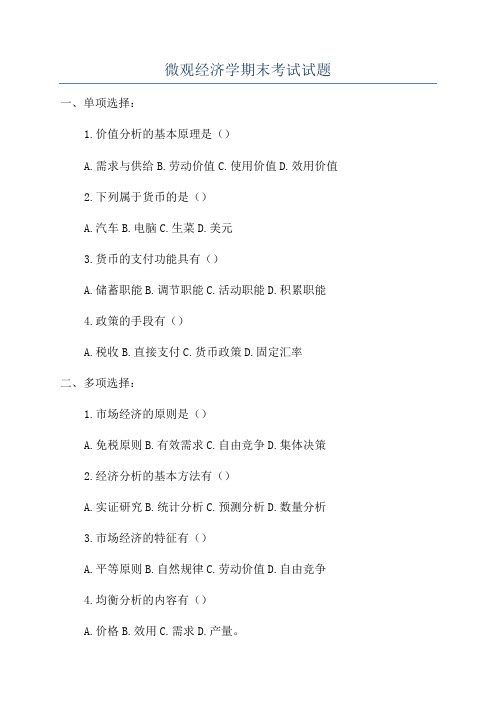
微观经济学期末考试试题
一、单项选择:
1.价值分析的基本原理是()
A.需求与供给
B.劳动价值
C.使用价值
D.效用价值
2.下列属于货币的是()
A.汽车
B.电脑
C.生菜
D.美元
3.货币的支付功能具有()
A.储蓄职能
B.调节职能
C.活动职能
D.积累职能
4.政策的手段有()
A.税收
B.直接支付
C.货币政策
D.固定汇率
二、多项选择:
1.市场经济的原则是()
A.免税原则
B.有效需求
C.自由竞争
D.集体决策
2.经济分析的基本方法有()
A.实证研究
B.统计分析
C.预测分析
D.数量分析
3.市场经济的特征有()
A.平等原则
B.自然规律
C.劳动价值
D.自由竞争
4.均衡分析的内容有()
A.价格
B.效用
C.需求
D.产量。
《微观经济学》课程期末考试试卷(A卷)
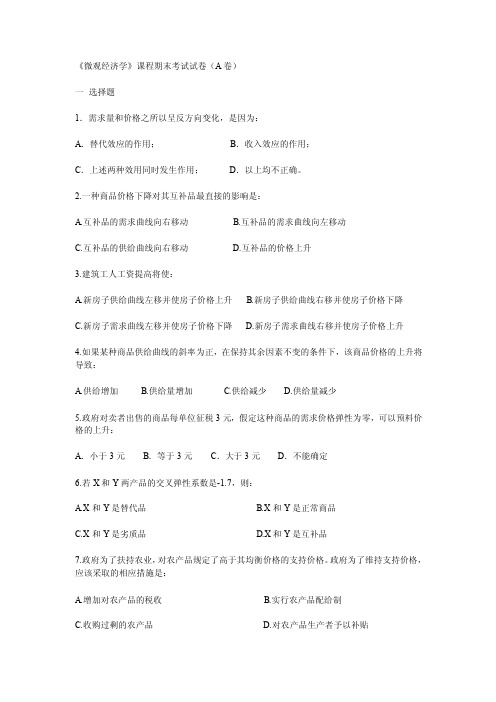
《微观经济学》课程期末考试试卷(A卷)一选择题1.需求量和价格之所以呈反方向变化,是因为:A.替代效应的作用;B.收入效应的作用;C.上述两种效用同时发生作用;D.以上均不正确。
2.一种商品价格下降对其互补品最直接的影响是:A.互补品的需求曲线向右移动B.互补品的需求曲线向左移动C.互补品的供给曲线向右移动D.互补品的价格上升3.建筑工人工资提高将使:A.新房子供给曲线左移并使房子价格上升B.新房子供给曲线右移并使房子价格下降C.新房子需求曲线左移并使房子价格下降D.新房子需求曲线右移并使房子价格上升4.如果某种商品供给曲线的斜率为正,在保持其余因素不变的条件下,该商品价格的上升将导致:A.供给增加B.供给量增加C.供给减少D.供给量减少5.政府对卖者出售的商品每单位征税3元,假定这种商品的需求价格弹性为零,可以预料价格的上升:A.小于3元B.等于3元C.大于3元D.不能确定6.若X和Y两产品的交叉弹性系数是-1.7,则:A.X和Y是替代品B.X和Y是正常商品C.X和Y是劣质品D.X和Y是互补品7.政府为了扶持农业,对农产品规定了高于其均衡价格的支持价格。
政府为了维持支持价格,应该采取的相应措施是:A.增加对农产品的税收B.实行农产品配给制C.收购过剩的农产品D.对农产品生产者予以补贴8.当LAC曲线下降时,LAC曲线切于SAC曲线的最低点:A.总是对的B.不对C.有时对D.无法判断9. 在完成竞争市场上,厂商短期均衡条件是:A.P=AR B.P=MR C.P=MC D.P=AC10.随着产量的增加,短期平均可变成本:A.先减少后增加B.先增加后减少C.按一定的固定比率在增加D.保持不变11. 假定X、Y的价格Px、Py已定,当MRSxy>Px/Py时,消费者为达到最大满足,他将:A. 增购X,减少YB. 减少X,增购YC. 同时增购X、YD. 同时减少X、Y12. 假定完全竞争行业内某厂商在目前产量水平上的边际成本、平均成本和平均收益均等于6元,则这家厂商:A.肯定只得到正常利润B.肯定没得到最大利润C.是否得到了最大利润还不能确定D.肯定得到了最少利润13. 一个具有m个厂商的古诺模型中,每个厂商的均衡产量为市场总容量的:A. B. C. D.14. 成本递减行业的长期供给曲线是:A.水平直线B.自左向右上倾斜C.垂直于横轴D.自左向右下倾斜15. 厂商将在何条件下面临停止营业:A. P=A VC B.TR=TVC C.企业总损失等于TFC D.以上都对16.当垄断市场的需求富有弹性时,TR为:A.递增B.递减C.0D.117. 规模收益递减是在下述情况下发生的:A.连续地投入某种生产要素而保持其他生产要素不变B.按相同比例连续增加各种生产要素C.不按比例连续增加各种生产要素D.上述都正确18. 垄断竞争厂商长期均衡点上,长期平均成本曲线处于:A.上升阶段B.下降阶段C.水平阶段D.均有可能19. 垄断竞争厂商实现最大利润的途径是:A.调整价格从而确定相应产量B.品质竞争C.广告竞争D.以上都可能20. 完全竞争市场中厂商总收益曲线的斜率为:A.固定不变B.可变的C.1D.021. 假定玉米市场的需求是缺乏弹性的,玉米的产量等于销售量且等于需求量,恶劣的气候条件使玉米产量下降20%,在这种情况下:A.玉米生产者的收入减少,因为玉米产量下降20%B.玉米生产者的收入增加,因为玉米价格上升低于20%C.玉米生产者的收入增加,因为玉米价格上升超过20%D.玉米生产者的收入减少,因为玉米价格上升低于20%22. 正常利润是:A.经济利润的一部分B.经济成本的一部分C.隐含成本的一部分D.B和C都对23. 预算线反映了:A.消费者的收入约束B.消费者的偏好C.消费者人数D.货币的购买力24. 形成不完全竞争市场的原因是:A.对生产要素的垄断B.法律方面的进入壁垒C.产品差异化D.以上都对25. 经济物品是指:A.有用物品B.稀缺物品C.要用钱购买的物品D.有用且稀缺的物品26. 在某产量水平上,厂商平均成本达到最小,意味着:A.边际成本等于平均成本B.厂商获得最大利润C.厂商获得最小利润D.厂商的超额利润为零27. 下列行业中哪一个最接近完全竞争市场状况:A.医药B.家电C.小麦D.化妆品28. 某行业许多生产者都生产标准化产品,它的需求是:A.无弹性B.单一弹性C.缺乏弹性D.富有弹性29. 若小王消费牛奶和面包时的边际替代率为1/4,即一单位牛奶相当于1/4单位的面包,则:A. 牛奶价格为4,面包价格为1时,小王获得最大效用B. 牛奶价格为1,面包价格为4时,小王获得最大效用C. 牛奶价格为10,面包价格为2时,小王应增加牛奶的消费D. 以上都不对30. 如果一个价格歧视垄断者对学生收取低价格,那么,它就是相信:A.学生的需求是富有弹性的B.学生的需求是缺乏弹性的C.想使学生的需求曲线移动D.学生的购买能力强二、判断题1. 在一个完全竞争行业中,没有一个企业能对产品的市场价格有任何重要的影响。
《微观经济学》期末测试题及答案

《微观经济学》期末测试题及答案第一套题一、名词解释:1. 需求:在一定的时间和价格条件下,消费者愿意并且能够购买的商品或服务的数量。
2. 供给:在一定的时间和价格条件下,生产者愿意并且能够提供的商品或服务的数量。
3. 均衡价格:在市场上,需求量和供给量相等时的价格。
4. 边际效用:消费者从消费最后一单位商品或服务中获得的额外满足度。
5. 生产可能性边界:在一定的资源和技术条件下,一个经济体所能生产的各种商品的最大组合。
二、填空题:1. 在需求曲线上,价格与需求量的关系是______。
(反向关系)2. 当边际成本大于边际收益时,企业应该______产量。
(减少)3. 消费者剩余是指消费者的______超过其实际支付的价格部分。
(意愿支付)4. 在完全竞争市场中,企业的短期供给曲线是______曲线在平均可变成本之上的部分。
(边际成本)5. _____是市场经济中最基本的价格决定机制。
(供求机制)三、单项选择题:1. 下列哪种情况会导致需求曲线向右移动?(B)A. 商品价格上升B. 消费者收入增加C. 替代品价格下降D. 商品的生产成本增加2. 当市场价格低于均衡价格时,市场上会出现(C)。
A. 供大于求B. 供求平衡C. 供不应求D. 不确定3. 在生产者理论中,当边际收益小于边际成本时,生产者应(A)。
A. 减少产量B. 增加产量C. 保持产量不变D. 关闭生产4. 市场经济中,资源配置的主要方式是通过(D)。
A. 政府计划B. 行业协会规定C. 企业自主决策D. 价格机制5. 下列哪种市场结构中,企业具有最大的定价能力?(D)A. 完全竞争市场B. 垄断竞争市场C. 寡头垄断市场D. 完全垄断市场四、多项选择题:1. 下列哪些因素会影响需求?(ABCD)A. 消费者收入B. 商品价格C. 相关商品的价格D. 消费者的偏好2. 下列哪些情况下,企业的供给曲线会向右移动?(AC)A. 生产技术进步B. 生产成本增加C. 原材料价格下降D. 政府提高税收3. 下列关于边际效用的说法正确的是?(BC)A. 边际效用总是递增的B. 边际效用可能为负C. 总效用达到最大时,边际效用为零D. 边际效用不能用于衡量消费者的总满足度4. 市场失灵的原因可能包括?(ABCD)A. 公共物品的存在B. 外部性的影响C. 垄断的存在D. 信息不对称5. 下列哪些市场结构中,企业可以设定价格?(AD)A. 完全垄断市场B. 完全竞争市场C. 垄断竞争市场D. 寡头垄断市场五、判断题:1. 如果一种商品的需求价格弹性大于1,那么该商品是必需品。
浙江工业大学《中级微观经济学》2021-2022学年第一学期期末试卷

浙江工业大学《中级微观经济学》2021-2022学年第一学期期末试卷课程名称:中级微观经济学专业:经济学班级:经济学 2021级考试形式:闭卷考试满分:100分---注意事项:1. 本试卷共四部分,总分100分。
考试时间为120分钟。
2. 请将答案写在答题纸上,写在试卷上的答案无效。
3. 所有题目必须回答,选择题请将正确答案的字母填在答题纸上,其余题目请将答案写清楚。
---第一部分选择题(共20题,每题2分,共40分)1. 在微观经济学中,消费者选择的基本假设是()A. 理性选择B. 无差异曲线C. 预期效用理论D. 边际效用递减2. 如果一种商品的价格上升,其他条件不变,该商品的需求量通常()A. 上升B. 下降C. 不变D. 无法确定3. 市场均衡是指()A. 供给等于需求B. 价格稳定C. 生产者和消费者都获得最大效用D. 市场没有外部性4. 供给曲线的右移通常表示()A. 生产成本上升B. 生产者对价格敏感度增加C. 生产者愿意在每个价格水平上提供更多商品D. 消费者对商品的需求减少5. 在完全竞争市场中,企业的边际收益等于()A. 产品的价格B. 平均成本C. 总收益D. 边际成本6. 当一项政策导致社会福利增加时,通常表示()A. 资源的有效配置B. 政府的干预过度C. 市场失灵D. 外部性存在7. 价格弹性为负数的商品通常是()A. 完全替代品B. 完全无弹性商品C. 正常商品D. 劣等商品8. 垄断市场的主要特征是()A. 存在多个卖方B. 产品差异化C. 价格接近边际成本D. 唯一的卖方9. 在生产可能性边界上,表示()A. 资源的有效利用B. 资源的无效利用C. 不可能的生产组合D. 未来的生产可能性10. 边际成本是指()A. 总成本与产量之比B. 增加一单位产量所增加的总成本C. 固定成本与变动成本之和D. 生产每个单位产品所需的总时间11. 在垄断竞争市场中,企业的短期利润会引起()A. 新企业的进入B. 老企业的退出C. 行业的均衡D. 价格的下降12. 如果一个企业的平均成本低于市场价格,则该企业()A. 会退出市场B. 会继续生产C. 会降低产量D. 会提高价格13. 影响价格弹性的因素主要包括()A. 替代品的可得性B. 商品的必要性C. 消费者的收入水平D. 所有上述因素14. 公共物品的特征是()A. 非排他性和非竞争性B. 排他性和竞争性C. 只能由政府提供D. 只能由私人提供15. 在分析市场时,成本和收益的变化通常影响()A. 需求曲线B. 供给曲线C. 市场均衡D. 消费者剩余16. 在竞争市场中,长期均衡时企业的经济利润为()A. 正值B. 负值C. 零D. 无法确定17. 消费者剩余是指()A. 消费者支付的总费用B. 消费者愿意支付的最高价格与实际支付价格之间的差额C. 市场价格与平均成本的差额D. 生产者的边际收益18. 当市场发生外部性时,通常需要()A. 自然调整B. 政府干预C. 企业合作D. 增加市场竞争19. 需求的价格弹性小于1表示()A. 需求弹性B. 需求无弹性C. 需求完全无弹性D. 需求单位弹性20. 在完全竞争市场中,长期均衡的条件是()A. 边际成本等于价格B. 平均成本等于边际成本C. 企业无经济利润D. 所有上述条件---第二部分填空题(共10题,每题2分,共20分)1. 微观经济学的研究对象主要是 ________ 和 ________。
《微观经济学》期末考试题
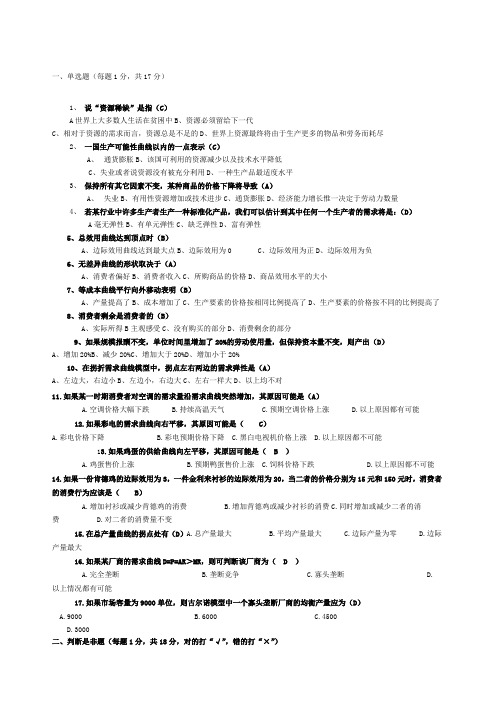
一、单选题(每题1分,共17分)1、说“资源稀缺”是指(C)A世界上大多数人生活在贫困中B、资源必须留给下一代C、相对于资源的需求而言,资源总是不足的D、世界上资源最终将由于生产更多的物品和劳务而耗尽2、一国生产可能性曲线以内的一点表示(C)A、通货膨胀B、该国可利用的资源减少以及技术水平降低C、失业或者说资源没有被充分利用D、一种生产品最适度水平3、保持所有其它因素不变,某种商品的价格下降将导致(A)A、失业B、有用性资源增加或技术进步C、通货膨胀D、经济能力增长惟一决定于劳动力数量4、若某行业中许多生产者生产一种标准化产品,我们可以估计到其中任何一个生产者的需求将是:(D)A毫无弹性B、有单元弹性C、缺乏弹性D、富有弹性5、总效用曲线达到顶点时(B)A、边际效用曲线达到最大点B、边际效用为0C、边际效用为正D、边际效用为负6、无差异曲线的形状取决于(A)A、消费者偏好B、消费者收入C、所购商品的价格D、商品效用水平的大小7、等成本曲线平行向外移动表明(B)A、产量提高了B、成本增加了C、生产要素的价格按相同比例提高了D、生产要素的价格按不同的比例提高了8、消费者剩余是消费者的(B)A、实际所得B主观感受C、没有购买的部分D、消费剩余的部分9、如果规模报酬不变,单位时间里增加了20%的劳动使用量,但保持资本量不变,则产出(D)A、增加20%B、减少20%C、增加大于20%D、增加小于20%10、在拐折需求曲线模型中,拐点左右两边的需求弹性是(A)A、左边大,右边小B、左边小,右边大C、左右一样大D、以上均不对11.如果某一时期消费者对空调的需求量沿需求曲线突然增加,其原因可能是(A)A.空调价格大幅下跌B.持续高温天气C.预期空调价格上涨D.以上原因都有可能12.如果彩电的需求曲线向右平移,其原因可能是(C)A.彩电价格下降B.彩电预期价格下降C.黑白电视机价格上涨D.以上原因都不可能13.如果鸡蛋的供给曲线向左平移,其原因可能是( B )A.鸡蛋售价上涨B.预期鸭蛋售价上涨C.饲料价格下跌D.以上原因都不可能14.如果一份肯德鸡的边际效用为3,一件金利来衬衫的边际效用为20,当二者的价格分别为15元和150元时,消费者的消费行为应该是(B)A.增加衬衫或减少肯德鸡的消费B.增加肯德鸡或减少衬衫的消费C.同时增加或减少二者的消费 D.对二者的消费量不变15.在总产量曲线的拐点处有(D)A.总产量最大 B.平均产量最大 C.边际产量为零 D.边际产量最大16.如果某厂商的需求曲线D=P=AR>MR,则可判断该厂商为( D )A.完全垄断B.垄断竞争C.寡头垄断D.以上情况都有可能17.如果市场容量为9000单位,则古尔诺模型中一个寡头垄断厂商的均衡产量应为(D)A.9000B.6000C.4500D.3000二、判断是非题(每题1分,共18分,对的打“√”,错的打“×”)1、经济学是研究怎样优化配置资源的科学。
微观经济学期末试题及答案
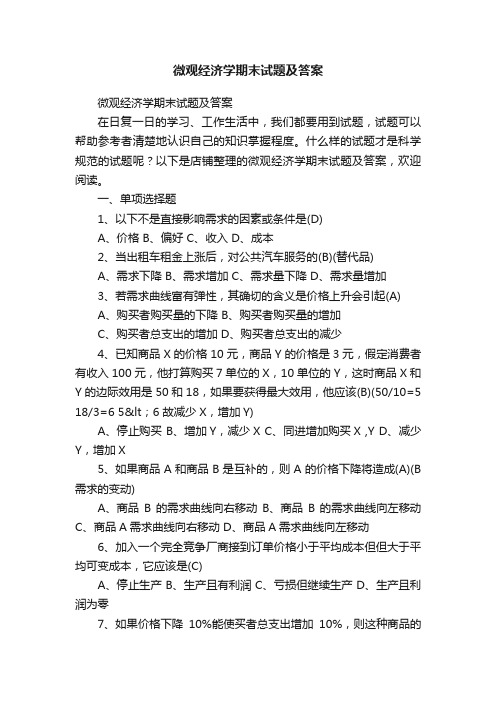
微观经济学期末试题及答案微观经济学期末试题及答案在日复一日的学习、工作生活中,我们都要用到试题,试题可以帮助参考者清楚地认识自己的知识掌握程度。
什么样的试题才是科学规范的试题呢?以下是店铺整理的微观经济学期末试题及答案,欢迎阅读。
一、单项选择题1、以下不是直接影响需求的因素或条件是(D)A、价格B、偏好C、收入D、成本2、当出租车租金上涨后,对公共汽车服务的(B)(替代品)A、需求下降B、需求增加C、需求量下降D、需求量增加3、若需求曲线富有弹性,其确切的含义是价格上升会引起(A)A、购买者购买量的下降B、购买者购买量的增加C、购买者总支出的增加D、购买者总支出的减少4、已知商品X的价格10元,商品Y的价格是3元,假定消费者有收入100元,他打算购买7单位的X,10单位的Y,这时商品X和Y的边际效用是50和18,如果要获得最大效用,他应该(B)(50/10=5 18/3=6 5<;6 故减少X,增加Y)A、停止购买B、增加Y,减少XC、同进增加购买X ,YD、减少Y,增加X5、如果商品A和商品B是互补的,则A的价格下降将造成(A)(B 需求的变动)A、商品B的需求曲线向右移动B、商品B的需求曲线向左移动C、商品A需求曲线向右移动D、商品A需求曲线向左移动6、加入一个完全竞争厂商接到订单价格小于平均成本但但大于平均可变成本,它应该是(C)A、停止生产B、生产且有利润C、亏损但继续生产D、生产且利润为零7、如果价格下降10%能使买者总支出增加10%,则这种商品的需求量对价格(A)A、富有弹性B、具有单位弹性C、缺乏弹性D、其弹性不能确定8、已知XY两种商品的交叉弹性—-0.4,则这两种商品是(C)A、独立品B、替代品C、补充品D、不能确定交叉弹性大于0,即是替代品,交叉弹性等于0,即是无相关,交叉弹性小于0,即是互补品9、在完全竞争市场中,厂商短期均衡条件是(C) (MR=SMC)A、P=ARB、P=MRC、P=MCD、P=AC10、市场均衡意味着(D)A、在某价格水平上供给数量等于需求数量B、在均衡价格水平上,每一个买者都可以买到想买的数量,每一个卖者都可以卖出想卖的数量C、价格没有变动的趋势D、上述答案均正确11、市场失灵是指(A)A、市场不能有效配置稀缺资源B、市场完全不好C、收入分配不均D、资源在私人部门和公共部门配置不均12、如果上游工厂污染了下游居民的饮水,按科斯定理(B),问题就可以妥善解决A、不管产权是否明确,只要交易成本为零B、只要产权明确,且交易成本为零C、只要产权明确,不管交易成本多大D、不论产权是否明确,交易成本是否为零13、市场不能提供纯粹公共产品是由于:(D)A、公共产品不具有竞用性B、公共产品不具有排他性C、消费者都想免费搭车D、以上三种情况都是14、吉芬商品表现为(B)A、需求收入弹性和需求价格弹性都是正值B、需求收入弹性为负,需求价格弹性为正C、需求收入弹性为正,需求价格弹性为负D、需求收入弹性和需求价格弹性都是负值15、若一种商品的`消费量随着消费者收入的增加而减少,一般来说,改商品是(D)A、正常品B、奢侈品C、必需品D、劣质品二、作图分析说明题1、作图说明赋税是如何造成经济剩余的无谓损失。
微观经济学期末考试98分答案

一、 单选题(题数:50,共 50.0 分) 1根据经济学的观点,以下哪一项属于个别需求和市场需求所涉及的产品:()(1.0 分)1.0 分 A、联合产品的私人产品 B、联合产品的公共产品 C、非联合产品的私人产品 D、非联合产品的公共产品我的答案:C 2根据微观经济学的观点,劳动力的供给由以下哪一组共同决定:()(1.0 分)1.0 分 A、平均效应和边际效应 B、边际效应和收入效应 C、替代效应和收入效应 D、替代效应和边际效应我的答案:C 3按照经济学原理的观点,以下哪一项是经济学的正确分类:()(1.0 分)1.0 分 A、人文经济学和自然经济学 B、灾害经济学和收益经济学 C、社会经济学和科技经济学 D、微观经济学和宏观经济学我的答案:D4在以下哪一种博弈策略的指导下,企业在囚徒困境中会出现两败俱伤的结局: () (1.0 分)1.0 分 A、所有的单纯策略 B、所有的混合策略 C、最优的单纯策略 D、最劣的混合策略我的答案:D 5以下哪一项是马尔萨斯人口论的支柱理论:()(1.0 分)1.0 分 A、货币边际产量递增 B、时间边际产量递减 C、土地边际产量递减 D、国家边际产量递增我的答案:C 6根据微观经济学的观点,“破釜沉舟”属于企业对博弈论中哪一种威胁的反击:()(1.0 分)1.0 分 A、不可变化威胁 B、可变化威胁 C、不可置信威胁 D、可置信威胁我的答案:D7当代政治学的选举投票理论与以下哪一种经济学理论有关:()(1.0 分)1.0 分 A、蛛网理论 B、凯恩斯理论 C、阿罗不可能定律 D、货币数量论我的答案:C 8根据微观经济学的观点,拉弗曲线在函数图表中显示为以下哪一种图形:()(1.0 分)1.0 分 A、波浪线 B、射线 C、抛物线 D、水平线我的答案:C 9国民经济账户体系(SNA)的主要纸币桥不包括()。
微观经济学试卷及答案
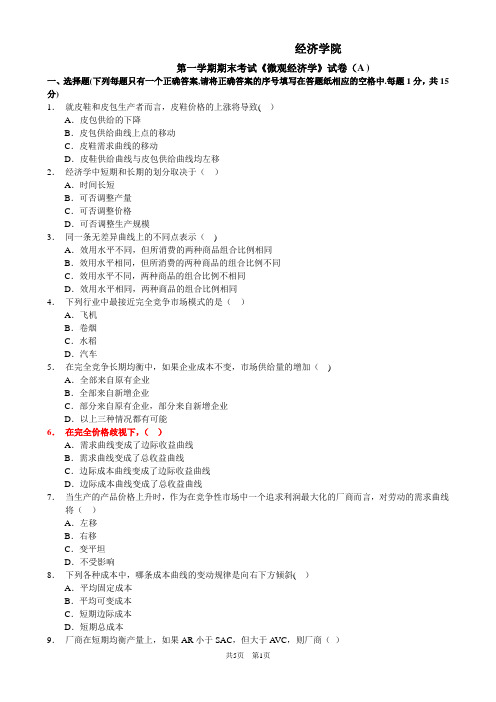
经济学院第一学期期末考试《微观经济学》试卷(A )一、选择题(下列每题只有一个正确答案,请将正确答案的序号填写在答题纸相应的空格中.每题1分,共15分)1.就皮鞋和皮包生产者而言,皮鞋价格的上涨将导致( )A.皮包供给的下降B.皮包供给曲线上点的移动C.皮鞋需求曲线的移动D.皮鞋供给曲线与皮包供给曲线均左移2.经济学中短期和长期的划分取决于()A.时间长短B.可否调整产量C.可否调整价格D.可否调整生产规模3.同一条无差异曲线上的不同点表示()A.效用水平不同,但所消费的两种商品组合比例相同B.效用水平相同,但所消费的两种商品的组合比例不同C.效用水平不同,两种商品的组合比例不相同D.效用水平相同,两种商品的组合比例相同4.下列行业中最接近完全竞争市场模式的是()A.飞机B.卷烟C.水稻D.汽车5.在完全竞争长期均衡中,如果企业成本不变,市场供给量的增加()A.全部来自原有企业B.全部来自新增企业C.部分来自原有企业,部分来自新增企业D.以上三种情况都有可能6.在完全价格歧视下,()A.需求曲线变成了边际收益曲线B.需求曲线变成了总收益曲线C.边际成本曲线变成了边际收益曲线D.边际成本曲线变成了总收益曲线7.当生产的产品价格上升时,作为在竞争性市场中一个追求利润最大化的厂商而言,对劳动的需求曲线将()A.左移B.右移C.变平坦D.不受影响8.下列各种成本中,哪条成本曲线的变动规律是向右下方倾斜( )A.平均固定成本B.平均可变成本C.短期边际成本D.短期总成本9.厂商在短期均衡产量上,如果AR小于SAC,但大于A VC,则厂商()A.亏损,但继续生产B.亏损,立即停产C.获利,继续生产D.亏损,生产与否都可10.下列关于洛伦兹曲线和基尼系数的论述,错误的是()A.洛伦兹曲线弯曲程度越大,基尼系数越大B.基尼系数越大,说明收入分配越不公平C.洛伦兹曲线越靠近对角线,说明基尼系数越大D.洛伦兹曲线和基尼系数都是描述收入分配公平程度的指标11.商品X、Y的价格按相同的比例上升,而收入不变,预算线( )A.向左下方平行移动B.向右下方平行移动C.不变动D.转动12.生产可能性边界图形的轴线用于衡量()A.生产性投入或资源的数量B.产成品的数量C.产成品的价值D.上述答案均正确13.如果边际成本在一定产量范围内大于平均成本,则在该范围内,产量的增加都将促使平均成本( )A.升高B.降低C.升高或降低取决于可变成本的变化D.保持不变14.假定某歌唱演员的年薪为10万元,但他(她)从事其他职业最多只能得到3万元,则这个演员所获得的经济租金为()A.10万元B.3万元C.7万元D.13万元15.帕累托最优配置是指( )A.总产量达到最大B.边际效用达到最大C.消费者得到他们想要的所有东西D.没有一个人可以在不使任何他人境况变坏的条件下使得自己境况变得更好二、判断题(在答题纸相应的空格中,正确的打“√”,错误的打“×”.每题1分,共10分)16.供给量是指在某一价格下,生产者愿意生产并且能够卖出去的数量。
《微观经济学》期末考试题及参考答案

《微观经济学》期末考试题及参考答案一、单项选择题(每小题1分,共15分)1.短期生产函数的短期是指()。
A.一年以内B.半年以内C.与具体时间长短无关D.时间非常短2.完全竞争市场厂商的总收益曲线是()。
A.以不变的斜率向上倾斜B.水平C.以不变的斜率向下倾斜D.垂直3.媒体刊登了一种补肾的“薏米山药粥”,配料是“薏米100克,山药200克,玫瑰花5克,大枣20克,冰糖适量”。
该条信息将会()。
A.使薏米的需求量增加B.使薏米的需求增加C.不一定,需求增加,供给也会增加D.使薏米的价格上升4.如果一个企业经历规模报酬不变阶段,则LAC曲线是()。
A.上升的B.下降的C.垂直的D.水平的5.不完全竞争的企业面对着向下倾斜的需求曲线,这意味着()。
A.它们对价格有一定程度的控制能力B.它们对价格有完全的控制能力C.它们不能控制价格D.需求是完全有弹性的6.如果等成本线在坐标平面上与等产量线相交,那么要生产等产量曲线表示的产量水平()。
A.还可以减少成本支出B.不能再减少成本支出C.应该再增加成本支出D.上述都不正确7.如果在需求曲线上有一点,ed=4,P=12元,则MR等于()。
A .30元B. 20元C. 9元D .15元8.微观经济学是经济学的一个分支,主要研究()。
A.市场经济B.个体行为C.总体经济活动D.失业和通货膨胀等9.由企业购买或租用任何生产要素所发生的成本是指( )。
A.显性成本B.隐性成本C.变动成本D.固定成本10.当一个完全竞争行业实现长期均衡时,每个企业()。
A.都实现了正常利润B.利润都为零C.行业中没有任何厂商再进出D.以上说法都对11.完全竞争企业在长期均衡状态下,成本不变的行业中,产量的增加量()。
A.完全来自新企业B.完全来自原有企业C.要么来自原有企业,要么来自新企业D.部分来自新企业,部分来自原企业。
12.假定X、Y的价格PX、PY已定,当MRSXY>PX/PY时,消费者为达到最大满足,他将()。
西方经济学微观部分期末考试试题及参考答案
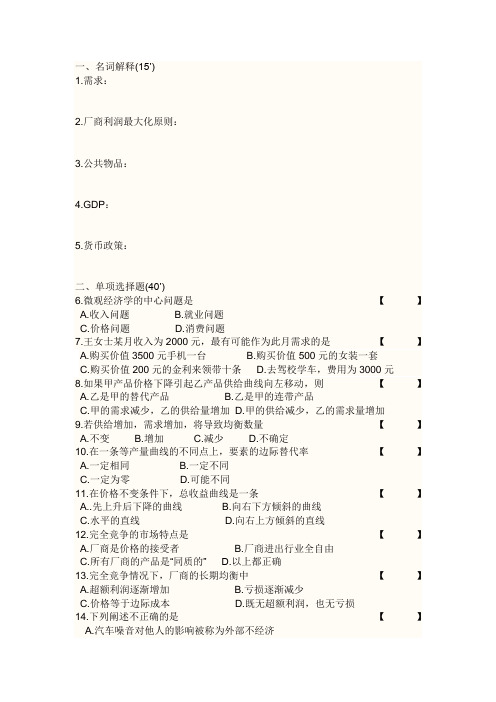
一、名词解释(15’)1.需求:2.厂商利润最大化原则:3.公共物品:4.GDP:5.货币政策:二、单项选择题(40’)6.微观经济学的中心问题是【】A.收入问题B.就业问题C.价格问题D.消费问题7.王女士某月收入为2000元,最有可能作为此月需求的是【】A.购买价值3500元手机一台B.购买价值500元的女装一套C.购买价值200元的金利来领带十条D.去驾校学车,费用为3000元8.如果甲产品价格下降引起乙产品供给曲线向左移动,则【】A.乙是甲的替代产品B.乙是甲的连带产品C.甲的需求减少,乙的供给量增加D.甲的供给减少,乙的需求量增加9.若供给增加,需求增加,将导致均衡数量【】A.不变B.增加C.减少D.不确定10.在一条等产量曲线的不同点上,要素的边际替代率【】A.一定相同B.一定不同C.一定为零D.可能不同11.在价格不变条件下,总收益曲线是一条【】A..先上升后下降的曲线B.向右下方倾斜的曲线C.水平的直线D.向右上方倾斜的直线12.完全竞争的市场特点是【】A.厂商是价格的接受者B.厂商进出行业全自由C.所有厂商的产品是“同质的”D.以上都正确13.完全竞争情况下,厂商的长期均衡中【】A.超额利润逐渐增加B.亏损逐渐减少C.价格等于边际成本D.既无超额利润,也无亏损14.下列阐述不正确的是【】A.汽车噪音对他人的影响被称为外部不经济B.如果社会成本大于私人成本就存在外部不经济C.社会成本的均衡价格比私人成本高D.外部经济不会导致市场失灵15.下列属于注入的是【】A.储蓄B.税收C.进口D.出口16.下列不属于政府的转移支付的是【】A.社会保障金B.国防经费C.企业救济金D.儿童福利基金17.下列不属于要素收入的是【】A.工厂发放给工人的加班补助B.某人出租房屋收到的租金C.股东红利D.资本折旧18.当就业量等于潜在就业量时,失业率【】A.等于零B.大于自然失业率C.小于自然失业率D.等于自然失业率19.古典货币数量理论认为,导致通货膨胀的直接原因是【】A.货币供给量增加B.货币的流通速度加快C.物价指数上升D.国民收入增加20.新剑桥学派认为发生“滞胀”的主要原因是【】A.政府过度增加货币供给量的结果B.赤字财政和通货政策的结果C.赤字财政和通货政策的结果D.以上都是21.根据储蓄函数关系,引起储蓄增加的因素是【】A.收入增加B.价格水平上升C.利息率上升D.预期收入减少22.根据货币需求理论,不影响货币需求的因素是【】A.债券的预期收益B.物品和劳务的相对价格C.一般物价水平D.预期的通货膨胀率23.假定某国的农业生产在世界上效率最高,那么【】A.该国不会进口食物B.该国将出口食物C.根据此假设仍不能决定该国出口或进口食物D.该国因生产自给而不能从贸易获得好处24.对人民币和美元两种货币来讲,如果人民币的汇率上升,则美元的汇率将【】A.上升B.下降C.无法确定D.不变25.在固定汇率制下,一国货币对他国货币的汇率【】A.绝对固定,没有波动B.基本固定,在一定范围内波动C.由外汇市场的供求关系自发地决定D.确定一个固定的比价,随一种货币或几种货币进行浮动26.已知消费函数为C=60+0.8Y,投资为自主投资,I=50,求:(1) 均衡的国民收入Y为多少?(2) 如果投资变为I=100,均衡的国民收入变为多少?(3) 投资乘数K为多少四、论述题:(30’)27.试述利润在经济中的作用。
2024年《微观经济学》期末考试题库(附答案)

2024年《微观经济学》期末考试题库(附答案)一、单选题1.其它条件不变,若某商品价格上升2%时,其需求量下降10%,则该商品的需求()A、缺乏弹性B、富有弹性C、具有单位弹性D、完全无弹性参考答案:B2.如果一个行业是一个成本递增行业,则()。
A、行业的长期供给曲线有一正的斜率B、行业的长期供给曲线有一负的斜率C、生产中使用的要素供给曲线是垂直的D、短期平均成本曲线不是U型的参考答案:A3..给消费者带来相同满足程度的商品组合集中在0A、生产可能性曲线上B、无差异曲线上C、预算约束曲线上D、需求曲线上参考答案:B4.在完全竞争市场中,厂商总收益曲线的斜率是()。
A、固定不变的B、经常变动的C、1D、O参考答案:A5.在MR=MC的均衡产量上,企业()。
A、必然得到最大利润B、必然得到最小利润C、若获利,则利润最大;若亏损,则亏损最小D、不可能亏损参考答案:C6.如果两种商品的需求交叉弹性为-2,则这两种商品是()A、正常商品B、劣等商品C、互补品D、替代品参考答案:C7.下列哪一项是实证经济学的说法OA、研究如何做出评价B、关注”应该是什么”C、从属于规范经济学D、预测行动的结果参考答案:D8.以下问题中哪一个不是微观经济学所考察的问题()A、一个厂商的产出水平B、失业率的上升或下降C、政府货物税的高税率对货物销售的影响D、某一行业中雇佣工人的数量参考答案:B9.帕累托最优实现的市场条件是()。
A、垄断市场;B、完全竞争市场;C、垄断竞争市场;D、三个市场均是。
参考答案:B10.在短期内,()是完全竞争厂商的收支相抵点。
A、SAC曲线与SMC曲线的交点B、MR曲线与SMC曲线的交点C、AVC曲线与SMC曲线的交点D、MR曲线与SAC曲线的切点参考答案:D11. 一个消费者想要一单位X商品的心情甚于想要一单位Y商品,原因是()。
A、商品X有更多的效用B、商品X的价格较低C、商品X紧缺D、商品X是满足精神需要的参考答案:A12.下列行业中哪一个最接近于寡头竞争市场()A、农产品市场B、电子通信市场C、服装市场D、运动鞋市场参考答案:B13.消费者的预算线反映了()A、消费者的收入约束B、消费者的偏好C、消费者的需求D、消费者效用最大化状态参考答案:A14.当某商品的需求和供给同时减少时,会导致()A、均衡价格下降,均衡产销量减少B、均衡价格无法确定,均衡产销量减少C、均衡价格上升,均衡产销量减少D、均衡价格下降,均衡产销量增加参考答案:B15.需求量与价格之所以呈反方向变化,是因为()A、收入效应的作用B、替代效应的作用C、产出效应作用D、收入效应和替代效应的共同作用参考答案:D16.根据完全竞争市场的条件,下列()行业最接近完全竞争行业。
《微观经济学》
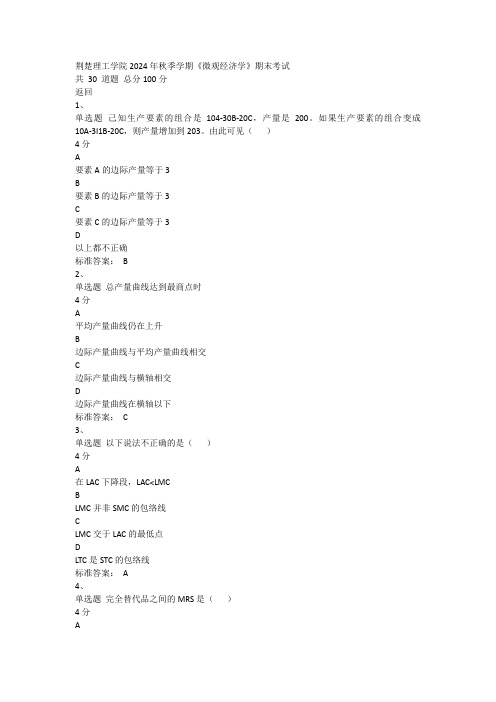
荆楚理工学院2024年秋季学期《微观经济学》期末考试共30 道题总分100分返回1、单选题己知生产要素的组合是104-30B-20C,产量是200。
如果生产要素的组合变成10A-3I1B-20C,则产量增加到203。
由此可见()4分A要素A的边际产量等于3B要素B的边际产量等于3C要素C的边际产量等于3D以上都不正确标准答案:B2、单选题总产量曲线达到最商点时4分A平均产量曲线仍在上升B边际产量曲线与平均产量曲线相交C边际产量曲线与横轴相交D边际产量曲线在横轴以下标准答案:C3、单选题以下说法不正确的是()4分A在LAC下降段,LAC<LMCBLMC并非SMC的包络线CLMC交于LAC的最低点DLTC是STC的包络线标准答案:A4、单选题完全替代品之间的MRS是()4分A递减的B等于0C固定不变的D递增的标准答案:C5、单选题下列说法中,错误的一种说法是4分AAC曲线最低点处于AVC曲线最低点的右上方BMC曲线上升时,AC曲线可能在下降CMC曲线下降时,AC曲线肯定也在下降DAC曲线上升时,MC曲线可能在下降标准答案:D6、单选题关于短期成本曲线,以下说法不正确的是4分AMC的最低点对应STC的拐点BMC先后穿过AC和AVC的最低点CMC递减区间对应STC的减速递增区间DAVC曲线与APL曲线相反对应标准答案:B7、单选题预算线以同横轴(代表X商品量)的交点为轴心,按顺时针方向运行,说明()。
4分AX价格下降:BX价格上升:CY价格下降:DY价格上升。
标准答案:C单选题微观经济学研究的核心议题是()4分A资源如何有效配置B消费者的购买决策C生产者的生产决策D政府的宏观调控政策标准答案:A9、单选题下列哪一项不会导致苹果的需求曲线向右移动?4分A生梨价格上升B桔子产量减少C对苹果营养价值的广泛宣传D消费者收入的下降标准答案:D10、单选题经济学分析中所说的短期是指()4分A一年之内B全部生产要素都可随产量调整的时期C至少有一种生产要素不能调整的时期D只能调整一年生产要素的时期标准答案:C11、单选题已知某企业生产的商品价格为10元,平均成本为11元,平均可变成本8元﹐则该企业在短期内()4分A停止生产且亏损B继续生产且亏损继续生产且有利润D停止生产且不亏损标准答案:B12、单选题一个完全竞争厂商利润最大化的条件是()。
微观经济学试题及答案

学期期末考试微观经济学试卷A一、单项选择题:(15分,请在四个备选答案中选择一个最适合的答案,填在括号内。
每小题1分,共15小题。
)1、经济学研究的基本问题是()。
A、怎样生产B、生产什么,生产多少C、为谁生产D、以上都包括2、下列命题中哪一个不是实证经济学命题()。
A、1981C、19823AC4A5A、C6A、3,7该产品的规模收益类型为()。
A、规模收益递增B、规模收益递减C、规模收益不变D、不能确定8、某企业产品总收入TR与产量Q的函数TR=-4Q2+80Q-108,那么总收入最大时的产量Q为()。
A、40B、30C、20D、109、在任何市场中,厂商的平均收益曲线可以由()。
A、他的产品的供给曲线表示B、他的产品需求曲线表示C、行业的产品供给曲线表示D、行业的产品需求曲线表示10、要能有效地实行差别定价,下列哪一条以外都是具备的条件()。
A、分割市场的能力B、保持市场分割以防止商品在较有弹性的需求时被雇客再售卖C、一个巨大的无弹性的总需求D、每个分市场上不同的需求价格弹性11、垄断竞争厂商的长期均衡与短期均衡的区别是长期均衡的()。
A、C、P=ACD12A13A14A15AC×。
每小题21.()如果需求量增加,需求一定增加。
2.()假定其他条件不变,某种商品价格的变化将导致它的供给量变化,但不会引起供给的变化。
3.()假定两商品的交叉弹性为-1.8,那么这两种商品是互补品。
4.()任意两条无差异曲线不能相交,否则交点的效用无法判断。
5.()就经济学意义而言,任意两种商品的边际替代率等于该两种商品的边际效用之比。
6.()如果边际产量递减,那么平均产量一定也是递减的。
7.()平均固定成本在所有产量上都是不变的。
8.()规模报酬递减意味着长期平均成本下降。
9.()完全竞争市场厂商会花费许多金钱为产品作广告。
10.()古诺双头垄断下的产量高于串谋时的产量。
三、简答题:(24分,简要回答以下问题。
微观经济学期末考试试卷(含答案解析)

微观经济学期末考试试卷(含答案解析)西⽅经济学(微观部分)期末考试试卷(A卷)考试科⽬:微观经济学考试类型:(闭卷)考试时间:120 分钟学号姓名年级专业⼀、单项选择题(每题0.5分,共15分,将正确答案填⼊答题纸上)1. 看不见的⼿⼀般指()A、机会成本B、政府C、利润D、价格2.经济学中的“稀缺性”是指()A 世界上⼤多数⼈⽣活在贫困中B、相对于资源的需求⽽⾔,资源总是不⾜的C⽤资源必须考虑下⼀代D、世界上的资源终将被⼈类消耗光3.如果x与y商品是互补品,x价格下降,将使y()A、需求量增加B、需求增加C、需求量减少D、需求减少4.冰棒的需求价格弹性()药品的需求价格弹性A、⼤于B、⼩于C 、等于D 、⼤于或等于5.下列命题中哪个是规范经济学的命题?( )A.征税对中等收⼊家庭是不公平的B. 1982年8⽉政府把贴现率降到10%C. 1981年失业率超过9%D.社会保险税的课税依据现已超过30000美元6.如果消费者的预算收⼊为50美元,商品X 和Y 的价格均为5美元,消费者打算购买6单位X 和4单位Y ,商品X 、Y 的边际效⽤分别为25和20,那么,要达到效⽤最⼤化,他应该()A 、按原计划购买B 、减少X 和Y 的购买量C 、增加X 、Y 的购买量D 、增加X 的同时减少Y 的量7.消费者预算线发⽣平移时,连接消费者均衡点的曲线称为()A 、需求曲线;B 、价格-消费曲线;C 、收⼊-消费曲线;D 、恩格尔曲线。
8.当某⼈⾯对⼀张彩票时,如果是212111UW P W PU W P PW U )()(])([-+?-+,则意味着这个⼈是属于下列哪⼀类⼈ ( )A .风险回避者B .风险喜爱者C .风险中⽴者D .都不是9.如果某⼚商增加⼀单位劳动使⽤量能够减少三单位资本,⽽仍⽣产同样的产出量,则MRTS LK 为:()A 1/3B 3C -3D 610. MC曲线达到最低时()A MP最⼤B AVC最⼩C TC最⼤D AC最⼩11.某⼚商每年从企业的总收⼊中取出⼀部分作为⾃⼰所提供的⽣产要素的报酬,这部分资⾦被视为()。
微观经济期末测试试题及答案
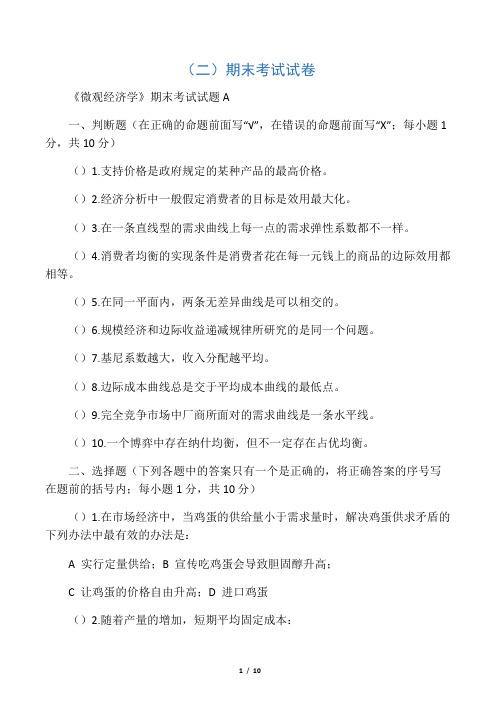
(二)期末考试试卷《微观经济学》期末考试试题A一、判断题(在正确的命题前面写“√”,在错误的命题前面写“X”;每小题1分,共10分)()1.支持价格是政府规定的某种产品的最高价格。
()2.经济分析中一般假定消费者的目标是效用最大化。
()3.在一条直线型的需求曲线上每一点的需求弹性系数都不一样。
()4.消费者均衡的实现条件是消费者花在每一元钱上的商品的边际效用都相等。
()5.在同一平面内,两条无差异曲线是可以相交的。
()6.规模经济和边际收益递减规律所研究的是同一个问题。
()7.基尼系数越大,收入分配越平均。
()8.边际成本曲线总是交于平均成本曲线的最低点。
()9.完全竞争市场中厂商所面对的需求曲线是一条水平线。
()10.一个博弈中存在纳什均衡,但不一定存在占优均衡。
二、选择题(下列各题中的答案只有一个是正确的,将正确答案的序号写在题前的括号内;每小题1分,共10分)()1.在市场经济中,当鸡蛋的供给量小于需求量时,解决鸡蛋供求矛盾的下列办法中最有效的办法是:A 实行定量供给;B 宣传吃鸡蛋会导致胆固醇升高;C 让鸡蛋的价格自由升高;D 进口鸡蛋()2.随着产量的增加,短期平均固定成本:A 增加;B 不变;C 减少;D 不能确定()3.最需要进行广告宣传的市场是:A 完全竞争市场;B 完全垄断市场;C 垄断竞争市场;寡头垄断市场()4.在消费者均衡时,消费者购买商品的总效用与他所支付的货币的总效用的关系是:A 前者小于后者;B 二者相等;C 前者大于后者;D 二者没有关系()5.当某厂商以最小成本生产出既定产量时,此厂商:A 总收益为零;B 一定获得了最大利润;C 一定未获得最大利润;D 无法确定是否获得了最大利润()6.下列哪一个不是完全竞争市场的特点:A 大量的卖者和买者;B 存在产品差别;C 资源完全流动;D 完全信息()7.垄断竞争市场中厂商达到短期均衡的产量的条件是,在该产量处:A 两条需求相交;B SMC=SMR;C 同时符合A和B;D LMC=LMR ()8.完全垄断市场中厂商的边际收益曲线:A 和需求曲线重合;B 是一条水平线;C 在需求曲线上方D 在需求曲线下方()9.在古诺双垄断模型处于均衡时,每个厂商提供潜在市场容量的:A ;;;D 1()10.xx制定统一价格的原则是:A 使整个卡特尔产量最大;B 使整个卡特尔利润最大;C 使整个卡特尔的边际成本最小;D 使整个卡特尔中各厂商的利润最大三、计算题(每小题10分,共20分)1.设汽油的需求价格弹性是0.15,现价格为每加仑1.20美元,试问汽油价格上涨到多少美元一加仑才能使其消费量减少10%?2.若厂商面对的需求曲线是Q= - P +50,分别求出厂商的总收益曲线、边际收益曲线和平均收益曲线?五、简答题(每小题10分,共30分)1、什么是生产要素边际报酬递减规律?答:边际技术替代率是指在维持产量水平不变的条件下,增加一个单位的某种要素投入量时所减少的另一种要素的投入数量。
微观经济学期末试卷

微观经济学期末试卷
一、单选题(每小题 2 分共 20 分)
1.经济发展优先级最高的是()
A.消费品
B.资本货投资
C.科技进步
D.基础产业
2.下列哪项不属于健康经济学研究的范畴()
A.医疗保健投入效益研究
B.基础设施建设研究
C.财政政策研究
D.货币政策研究
3.如果生产能力远大于需求,市场收入将出现()
A.超剩余
B.均衡
C.虚增
D.虚空
4.以下不属于微观经济学研究的是()
A.生产理论
B.消费理论
C.投资理论
D.政府理论
二、多选题(每小题 2 分共 10 分)
5.市场结构的几种类型是()
A.竞争性市场
B.垄断性市场
C.寡头垄断市场
D.联合垄断
市场
三、判断题(每小题 2 分共 10 分)
6.微观经济学是从宏观经济学中抽象出来的一个独立学科
A.正确
B.错误
四、问答题(每小题 10 分共 10 分)
7.经济增长的重要推动力是什么?
答:经济增长的重要推动力是科技进步和人力资本的投入。
科技
进步是改善和开发科学技术,提高产品质量和生产能力;人力资本是
指投入于劳动力获得生产能力,提高劳动力的技能水平和熟练程度。
两者都可以提高生产力,提高经济增长。
- 1、下载文档前请自行甄别文档内容的完整性,平台不提供额外的编辑、内容补充、找答案等附加服务。
- 2、"仅部分预览"的文档,不可在线预览部分如存在完整性等问题,可反馈申请退款(可完整预览的文档不适用该条件!)。
- 3、如文档侵犯您的权益,请联系客服反馈,我们会尽快为您处理(人工客服工作时间:9:00-18:30)。
The wage of an unskilleain, there are two inputs, skilled and unskilled labor. The wage of skilled workers is 50,000, that of unskilled workers is 20,000. The marginal product of an unskilled worker is 10. Thus,
8 points
3
Question 4 Consider a firm that minimizes production costs. (a) The firm has a production function f (K, L) = min{K, L}. Suppose that originally the price of K is r = 2 and the price of L is w = 3. Then the price of K increases 100%. Determine by what percentage production costs increase. 4 points
F=
,P=
.
The firm’s profit (per consumer) is
.
(b) The government introduces a tax of 2 Dollars on the firms per unit of output that is produced, i.e., the new cost function is C (Q) = 4Q. Then
F E E500, (W) Name: E-mail: @
December 10, 2007
All questions must be answered on this test form! For each question you must show your work and (or) provide a clear argument. Use the last two pages and the back of the form as scratch paper. Question 1 The profit of a firm before paying the manager’s salary is πb (e) = 80e − 0.1e2 , where e ≥ 0 is the manager’s effort. If w is the manager’s wage then the firm’s profit after paying the wage is πa (e, w) = 80e − 0.1e2 − w. The manager chooses an effort level e ≥ 0 that maximizes his payoff w − e. (a) Suppose the manager’s wage is w = 40 (independent of the manager’s effort). Then the 5 points
The cost of producing Q units of output increases by
%.
4
Question 5 Consider a firm that minimizes production costs. (a) Suppose that there are two inputs: Input 1 is skilled and input 2 is unskilled labor. Suppose that if the firm decreases skilled labor by 1 unit, then it would have to increase unskilled labor by 4 units in order to keep output the same. The marginal product of unskilled labor is 40. Thus,
(b) Now suppose that the supervisor must monitor the worker in order to determine the worker’s effort. Suppose that the worker knows that if he shirks (chooses low effort) then he is found out with probability p and he is fired. If he is fired, he can immediately get a job at some other firm, where he gets a utility of 5. Otherwise, he receives a wage of w = 30. 3 points The worker’s expected utility from choosing e = 1 is The worker’s expected utility from choosing e = 0 is (The answer(s) may depend on p)
Question 3 Fill in the missing entries in the table below Quantity of variable input 0 1 2 3 4 132 100 20 total output 0 marginal product of variable input — average product of variable input — 60
manager’s effort is e = the manager’s total compensation is
.
1
Question 2 A worker can choose to effort levels: High, e = 1 and low, e = 0. Let w be the workers wage. Then utility is given by u(w, e) = w − 10e. (a) Suppose that the person’s effort level can be observed by the supervisor. The worker receives a wage of wl = 10, if he chooses the low effort level. Then, in order to induce the worker to choose the high effort level, wh (the wage if he chooses e = 1) must be at least w h = 3 points
The cost of producing Q units of output increases by
%.
(b) Now suppose that the firm uses two inputs, x1 , x2 , with prices w1 and w2 . The output is given by Q = x1 + x2 . Suppose prices are originally, w1 = w2 = 2. Then the price of input 2 doubles. 4 points
2
(d) Explain briefly how the results are affected if firing workers is difficult, i.e., if a worker who is found to be shirking can only be fired with a small probability. 2 points
The marginal product of skilled labor is
.
3 points
(b) Again, suppose that there are two inputs, skilled and unskilled labor. Now, if the firm decreases skilled labor by 2 units, then it would have to increase unskilled labor by 7 units in order to keep output the same. Suppose that the wage of a skilled worker is 70,000. Then
Aggregate supply is QS ( P) = The equilibrium price is P = .
.
5 points
(b) Now suppose that the government introduces a tax of 9 Dollars on the firm per unit of output that is produced. Thus, the firms variable cost increases by 9Q. Then
The equilibrium price is P = The government’s tax revenue is
.
.
5 points
6
Question 7 A firm has a cost function C (Q) = 2Q. The demand of a typical consumer is Q(P) = 10 − 2P. (a) Suppose the firm uses the optimal (i.e., profit maximizing) two-part pricing schedule, consisting of a fixed fee F and a price per unit, P. Then 5 points
